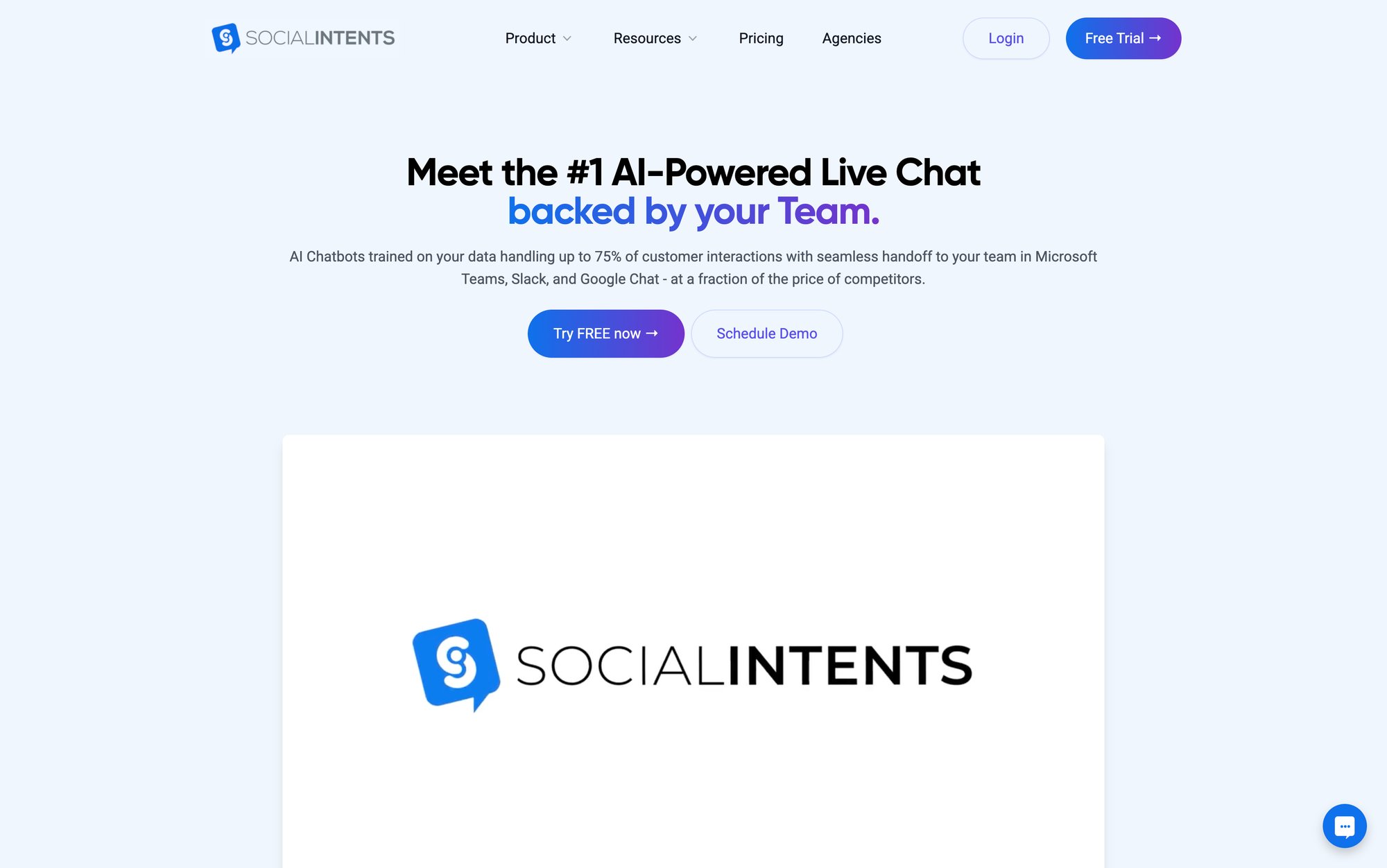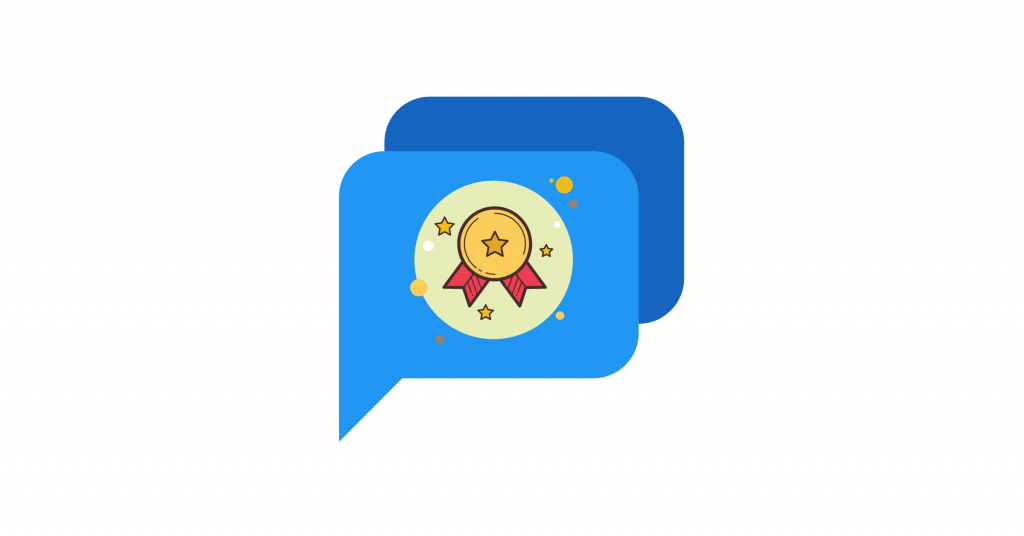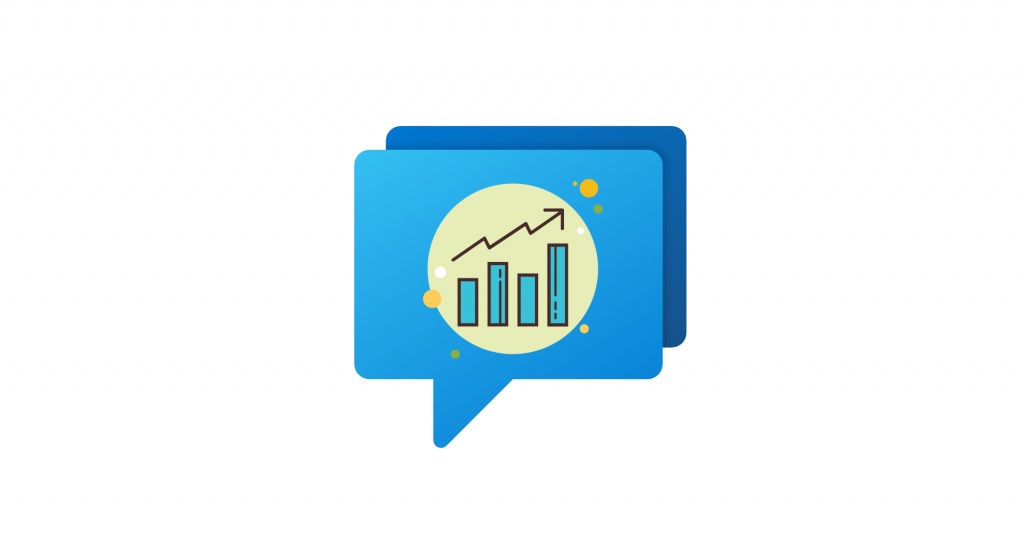Running an online store in 2025 means competing for attention in a crowded marketplace where customer expectations have never been higher. Shoppers want instant answers, personalized help, and zero friction on their path to purchase. If your site can't deliver that experience, they'll find one that can.
Live chat has become one of the most powerful tools for meeting these expectations. It lets you engage visitors in real time, answering questions, resolving concerns, and guiding them toward a purchase through a simple chat interface right on your website. The impact goes far beyond just better customer service. We're talking about measurable increases in sales, reduced cart abandonment, and customers who actually come back.
The numbers back this up. Research shows that 44% of online consumers consider having their questions answered by a live person during a purchase as one of the most important features a website can offer. That's not a nice to have. That's a make-or-break expectation.
This guide breaks down exactly why live chat has moved from optional to essential for ecommerce businesses. We'll look at the data, explore the benefits, and show you how tools like Social Intents make it easy to add powerful live chat to your store without rebuilding your entire support infrastructure.

How Live Chat Increases Sales and Conversion Rates
The most compelling reason to add live chat is simple: it directly increases your revenue. When customers can get instant answers and feel confident about their purchase, they're far more likely to complete it.
The conversion lift is real and measurable. Businesses that use live chat typically see an 8% to 20% increase in conversion rates. That's not a marginal improvement. For a store doing $500,000 in annual sales, even a 10% lift means an extra $50,000 in revenue from the same traffic.
What's driving this increase? Think about the last time you were about to buy something online but had a question. Maybe you weren't sure about sizing, shipping time, or return policy. If you couldn't get an answer quickly, you probably left. Live chat catches those moments of hesitation and turns them into completed purchases.
The data on buyer behavior tells the story: Visitors who engage with live chat are 2.8 times more likely to make a purchase. Even more telling, 38% of shoppers say they bought something specifically because of a chat conversation. The chat didn't just help them buy, it actually influenced their decision to buy.
But it's not just about closing more sales. It's also about increasing the value of each sale. Live chat creates natural opportunities for guidance and recommendations. A customer shopping for a laptop case might not realize they need a screen protector too. A quick chat suggestion can add that to the cart. Research from Forrester found that live chat engagements result in about 10% higher average order values compared to non-chat purchases.
The business impact shows up clearly in the bottom line. Studies show that 79% of companies report that offering live chat has positive effects on sales, revenue, and customer loyalty. Some businesses see even more dramatic results, with ROI exceeding 300%, particularly when using proactive chat to engage customers before they leave.
One retailer added live chat and tracked the results carefully. Their overall conversion rate jumped 3.8%, with a corresponding 6% increase in revenue. Those kinds of gains are hard to achieve through any other single change to your site.
How to Reduce Cart Abandonment with Real-Time Support
Cart abandonment is the silent killer of ecommerce revenue. Customers add items, get to checkout, and then vanish. The average cart abandonment rate hovers around 70%, meaning you're losing most potential sales at the final hurdle.
Live chat for ecommerce attacks this problem directly by catching customers at the moment they're about to leave.
|
Problem |
Traditional Approach |
Live Chat Solution |
|---|---|---|
|
Unanswered questions |
Static FAQ pages |
Instant real-time answers |
|
Shipping concerns |
Hope they find policy |
Proactive support offer |
|
Product uncertainty |
Lost sale |
Immediate clarification |
|
Trust barriers |
Generic trust badges |
Human reassurance |
A major reason for cart abandonment is unanswered questions. 45% of U.S. adults abandon purchases because they can't get quick answers to their questions. It might be a concern about shipping time, return policy, or product details. Live chat solves this by being there exactly when it matters. The customer types their question, gets an immediate response, and feels confident enough to complete the purchase. That simple intervention can save thousands of dollars in lost sales every month.

The power of real-time reassurance can't be overstated. A static FAQ page might answer the question, but it doesn't provide the personal confidence that comes from a conversation with a real person (or even a well-designed chatbot). When someone's about to spend $500 on electronics, they want to know a human is standing behind that purchase. 44% of consumers say having questions answered by a live person during purchase is one of the most important website features.
Smart implementation takes this further with proactive chat. Modern live chat tools can detect when someone is lingering on a checkout page or showing signs of hesitation. At that moment, a small chat window pops up: "Need any help completing your order?" Sometimes that gentle nudge, combined with instant availability, is all it takes to prevent abandonment.
Studies show that 48% of consumers favor companies that offer proactive live chat rather than waiting for customers to reach out first. It shows attentiveness. It makes your site feel like there's a real business behind it, not just an automated storefront.
Live chat also serves as a trust signal. Some customers abandon carts because they're not sure if your site is legitimate or if help will be available if something goes wrong. Research found that an online store is perceived as almost twice as trustworthy when it offers live chat. That perception shift alone can reduce anxiety-driven abandonment.
For ecommerce businesses, even small reductions in cart abandonment translate to significant revenue gains. If you're doing $1 million annually with a 70% abandonment rate, reducing that to 65% could mean tens of thousands in recovered sales.
Why Live Chat Builds Trust and Customer Loyalty
In ecommerce, you don't get the advantage of a friendly face greeting customers at the door. Your website has to build trust through other means. Live chat fills that gap by humanizing your online store and showing visitors there are real, helpful people (or intelligent systems) ready to assist them.
The impact on customer satisfaction is dramatic. When comparing support channels, live chat consistently ranks number one with an 88% satisfaction rate. Compare that to email at 61% and phone support at 44%. Customers love the speed and convenience of chat, and that positive experience translates directly into how they feel about your brand.
Higher satisfaction naturally leads to loyalty. Studies show that 60% of customers say they're more likely to return to a website that offers live chat support. Think about what that means for customer lifetime value. You're not just winning one sale. You're building relationships that lead to repeat purchases, higher order values over time, and word-of-mouth recommendations.
The personal touch matters more than you might think. Chat conversations feel more human than email exchanges or form submissions. Agents can use the customer's name, share quick screenshots to clarify something, or even add a genuine "Happy to help!" at the end. These small touches build rapport. When a customer has an issue and your chat team resolves it in minutes while showing real empathy, that customer remembers the experience.
Many companies underestimate how much trust comes from simply being available. When visitors land on your site and see a chat widget, it signals "we're here for you." It says you're confident enough in your business to offer immediate help. That confidence is contagious. Customers feel safer making a purchase because they know support is just a click away if anything goes wrong.
This trust factor becomes especially important for first-time visitors who don't know your brand yet. They might be comparing you to three other stores. The one with responsive live chat suddenly seems more legitimate and customer-focused than the others. That perception can be the deciding factor in where they make their purchase.
Live chat also creates a feedback loop that strengthens your business. When customers voice concerns or suggestions through chat, you're getting real-time insight into what's working and what's not. If ten people in a week ask about your return policy in chat, maybe your return policy page needs to be clearer. If customers keep asking about product dimensions, perhaps your product pages need better specifications. This continuous feedback helps you improve, which builds even more trust over time.
For building long-term customer relationships in ecommerce, live chat has become essential infrastructure, not just a support option.
How to Meet Customer Expectations for Speed and Convenience
Speed isn't just a nice feature in 2025. It's an expectation. Customers expect answers now, not in hours or days. Live chat delivers on that expectation in ways that no other channel can match.
The response time difference is stark:
|
Support Channel |
Average Wait Time |
Customer Experience |
|---|---|---|
|
Live Chat |
30-40 seconds |
Immediate, multitask-friendly |
|
Phone Support |
Several minutes |
Hold music, single-task |
|
Email Support |
Hours to days |
Asynchronous, frustrating |
With live chat, the average wait to connect with an agent is around 30 to 40 seconds. Many companies respond even faster. Compare that to phone support, where you might wait several minutes listening to hold music, or email support where you're waiting hours or even days for a response. Many companies aim to respond to initial chat messages in under one minute, and that speed has become the baseline expectation.
This immediacy has a direct impact on sales. When you can answer a customer's question while they're still actively shopping on your site, you dramatically increase the chances they'll buy. Once they click away to "think about it," you've likely lost them. Their attention moves on. Their intent cools. Live chat keeps them engaged and moving toward purchase.
The convenience factor goes beyond just speed. Chat fits into how people actually use the internet. 51% of customers prefer live chat specifically because they can multitask during the conversation. They can ask a question, continue browsing your products, check their email, and glance back at the chat when the agent responds. Try doing that with a phone call.
Phone support, by comparison, feels increasingly outdated to many customers. Being put on hold is the number one complaint about phone support for 61% of customers. Nobody enjoys holding a phone to their ear for ten minutes waiting for the next available representative. Live chat eliminates that frustration entirely. The queue is visible, the wait is short, and once connected, the conversation flows smoothly without the awkwardness of verbal communication barriers.
The efficiency extends to issue resolution as well. Many customer questions can be resolved in a single chat session, right there and then. Compare that to email, where resolving even simple issues might require three or four back-and-forth messages over two days. That's frustrating for customers and inefficient for your team. Chat's real-time nature lets both parties clarify and solve issues quickly, leading to higher satisfaction and less workload overall.
Modern customers also appreciate having a written record of the conversation. Unlike a phone call where they might need to take notes, a chat transcript is automatic. They can refer back to tracking numbers, instructions, or promises made during the chat. Some live chat systems even email the transcript to customers afterward, which provides additional peace of mind.
The expectation for speed and convenience isn't going away. If anything, it's intensifying. Customers who've experienced instant chat support on one site will expect it everywhere. Companies that meet this expectation win customers. Those that don't increasingly find themselves at a competitive disadvantage.
How to Provide 24/7 Support Without Hiring More Staff
Your ecommerce store is open 24 hours a day, serving customers across time zones and continents. Your support, though, probably isn't. That gap represents lost sales, frustrated customers, and missed opportunities.
Live chat, particularly when combined with AI chatbots, lets you provide round-the-clock support without hiring a massive overnight team.
The 24/7 Coverage Strategy:
① AI handles routine questions (FAQs, shipping, returns, product details)
② Humans take complex issues (during business hours)
③AI collects information (for follow-up when offline)

Think about what happens when a customer in Australia visits your U.S.-based store at 2 AM Eastern time. They have a question about shipping. Without live chat, they're stuck. They might email and wait 8 hours for a response (by which time they've probably bought from a competitor), or they might just leave immediately. With live chat and an AI assistant, they get an instant response. The bot can answer common questions about shipping, returns, and product details immediately. For more complex issues, it can collect the customer's information and promise a human follow-up during business hours.
Social Intents offers exactly this kind of hybrid approach. You can train an AI chatbot on your FAQs, product information, and knowledge bases. The bot handles initial greetings and common questions. When the inquiry gets complex or the customer specifically requests a human, the chat seamlessly transfers to your team. From the customer's perspective, they got immediate help followed by personalized human attention. From your perspective, you've provided 24/7 coverage without staffing multiple shifts.
This approach works particularly well for international customers. Someone in Tokyo doesn't have to wait until your California office opens to get help. They can engage with your chatbot immediately, get answers to straightforward questions, and either complete their purchase or leave a message for follow-up. Either way, you've kept them engaged instead of losing them to the "business hours only" barrier.
Some live chat systems even include real-time translation features. An agent in English can communicate with a customer in French, with the system translating in both directions. This capability opens up global markets that would otherwise be difficult to serve. Social Intents includes features like this, making international support accessible even for smaller teams.
The after-hours capability extends beyond just support. A well-configured chatbot can capture leads and even guide customers through orders when humans aren't available. If someone needs a product urgently at midnight, the bot can help them find it, add it to cart, and complete checkout. If they have questions the bot can't answer, it captures their contact information so your sales team can follow up first thing in the morning with a warm lead already in the system.
The efficiency gains here are substantial. You get the benefit of 24/7 availability without the cost of round-the-clock staffing. Your chatbot handles the volume during off hours, and your human team focuses on complex issues and high-value interactions during business hours. It's the best of both worlds.
How Live Chat Reduces Support Costs While Improving Efficiency
Live chat doesn't just benefit customers. It makes your support operation significantly more efficient and cost-effective.
The efficiency gain starts with capacity. A single chat agent can typically handle 2-3 conversations simultaneously, depending on complexity. Industry data shows an average support agent manages around 30 or more chats per day. Now compare that to phone support, where one agent can only handle one call at a time. The math is simple: you need fewer agents to handle the same volume of customer inquiries. That directly reduces your labor costs for support.
|
Efficiency Metric |
Live Chat |
Phone Support |
Email Support |
|---|---|---|---|
|
Concurrent handling |
2-3 conversations |
1 call only |
Multiple (async) |
|
Daily capacity |
30+ interactions |
15-20 calls |
20-30 emails |
|
Resolution speed |
Minutes |
10-15 minutes |
Hours to days |
|
Customer satisfaction |
88% |
44% |
61% |
The savings compound when you add chatbots to the mix. Bots can handle FAQs and routine questions completely autonomously, deflecting those contacts from your human team. Businesses reduce customer service costs by up to 30% by adding chatbots to their live chat setup. Those savings come from needing fewer agents while maintaining (or improving) service levels. Every routine question the bot answers is one less interaction your team needs to handle.

Tools like Social Intents make this even more practical by integrating directly with platforms your team already uses. Instead of learning a new support interface, your agents can respond to chats right from Microsoft Teams, Slack, Google Chat, or Zoom. This reduces training time, increases adoption, and means you don't need to pay for another separate tool. Your team stays in their familiar workspace, and customer chats just flow in as messages they can respond to naturally.
The integration aspect delivers another often-overlooked benefit: faster onboarding for support staff. When a new support agent joins your team, they don't need to learn a complex helpdesk system. They just need to know how to use Teams or Slack, which they probably already know. Getting them up to speed on chat support becomes a matter of training them on your policies and products, not on navigating unfamiliar software.
Resolution times also play a role in efficiency. Live chat tends to resolve issues faster than email, which means your agents can help more customers in the same amount of time. Instead of an email chain that takes 48 hours and six messages to resolve an issue, a 10-minute chat gets it done. That faster resolution frees your agents to help the next customer sooner, increasing overall throughput.
There's also a retention angle to the cost savings. Studies show that 40% of customers stop doing business with brands due to poor service experiences. Live chat helps you deliver good service experiences, which means you keep more customers. Keeping existing customers is far cheaper than acquiring new ones. Every customer you retain through better service is money saved on marketing and acquisition costs.
From a productivity standpoint, chat agents can work more efficiently than phone agents. They can use saved responses for common questions, share links to help articles, and even use AI assistance for drafting responses. Many chat platforms let agents pull up customer information and order history automatically, so they can resolve issues without tedious back-and-forth asking for details. All of this streamlines the work and reduces the time per interaction.
Studies show that 81% of customer service teams plan to increase their investment in live chat, which tells you something important: it delivers results both for customers and for the business. It's rare to find a tool that simultaneously improves customer satisfaction and reduces operational costs, but live chat does both.
How to Capture More Leads and Gain Customer Insights with Chat
Every visitor to your site represents a potential customer, but most will leave without buying and without identifying themselves. Live chat turns anonymous browsers into identified leads and gives you invaluable data on what your customers actually want.
Consider a typical scenario: Someone lands on your pricing page, spends three minutes looking at different plans, then leaves. Without live chat, you know nothing about who they were or why they didn't convert. With proactive live chat, a message pops up: "Questions about which plan is right for you?" They engage, ask a few questions, and even if they don't buy immediately, you've now captured their email address and learned what their concerns were. That's a lead you can follow up with.

Live chat can increase the number of leads by up to 40% simply by engaging visitors who would otherwise have left anonymously. Four out of ten people who might have been lost are now in your pipeline, with context about what they're looking for.
The ease of starting a chat makes this possible. Studies show that 42% of consumers prefer live chat when it comes to sharing contact information or getting questions answered. It feels natural and low-pressure. Compared to filling out a long form, starting a conversation is psychologically easier. People are willing to share information when they feel they're getting value in return (immediate answers to their questions).
But live chat doesn't just capture leads, it qualifies them. Through the conversation, your agents (or bots) can ask qualifying questions that help determine how serious the prospect is. Are they looking to buy soon or just researching? What's their budget range? What features matter most to them? By the end of a chat, you might know whether this is a hot lead worth immediate sales follow-up or someone to nurture over time.
This real-time qualification saves your sales team enormous amounts of time. Instead of calling every lead blindly, they can focus on the ones chat interactions have identified as high-value. A furniture store, for example, might learn through chat that a visitor is opening a new office next month and needs to furnish 20 workstations. That's a lead worth prioritizing.
Beyond lead generation, chat transcripts are a goldmine of customer insight. Every question asked reveals something about your customer's needs, concerns, or confusion. Review your chat logs and you'll spot patterns. Maybe customers keep asking if your product works with a specific platform. Maybe they're confused about your return policy. Maybe they want a feature you don't offer yet. All of this is feedback you can act on to improve your site, your products, and your marketing.
Most live chat platforms include analytics that help surface these insights automatically. You can see which pages generate the most chat requests (indicating confusion or high interest), what questions get asked most frequently (suggesting FAQ gaps), and where customers drop off even after chatting (potential conversion barriers). This data helps you optimize your entire funnel, not just your support process.
There's also a personalization angle. Information gathered during chats can be used to tailor future interactions. If a customer chatted about being interested in hiking gear, you can follow up with emails about new hiking products. If they asked about a product that was out of stock, you can proactively notify them when it's back. Personalized communication like this can increase customer engagement by as much as 55%.
Live chat turns your website from a passive information display into an active intelligence-gathering tool. You're filling your sales pipeline while simultaneously learning what makes your customers tick. For a growing ecommerce business, that dual benefit is invaluable.
How Social Intents Makes Live Chat Easy for Ecommerce
If you're convinced that live chat is essential but worried about the complexity of implementation, modern platforms have made it remarkably straightforward. Social Intents is designed specifically to remove the friction from adding live chat to your ecommerce store.
The biggest advantage is how Social Intents integrates with tools your team already uses. Instead of forcing your support staff to learn yet another platform, Social Intents routes website chats directly into Microsoft Teams, Slack, Google Chat, Zoom, or Webex. Your team responds to customer chats right from the collaboration tool they're already in all day. This means near-instant adoption with minimal training. Setup typically takes minutes, not days.

For ecommerce specifically, Social Intents offers native integrations with major platforms. If you're running on Shopify, BigCommerce, Wix, or WordPress, there are pre-built apps and plugins that make installation plug-and-play. You don't need to mess with code or worry about breaking your site. Install the app, configure your preferences, and you're live.
The AI capabilities are particularly valuable for ecommerce stores. You can train Social Intents' chatbot on your product catalog, FAQs, shipping policies, and any other content. The bot then handles initial inquiries automatically, answering questions about product details, order status, return policies, and more. When the question gets complex or the customer wants a human, the conversation seamlessly transfers to your team.
This hybrid human plus AI approach means you get 24/7 coverage without staffing three shifts. The bot handles routine questions around the clock. Your human agents focus on complex issues, sales conversations, and situations requiring empathy or judgment. It's the most efficient way to scale support as your store grows.
Key Social Intents Features for Ecommerce:
-
Unlimited agents starting at the Basic plan means you can have your entire team available to help during peak times without worrying about per-agent pricing. During Black Friday rush or a product launch, you can throw your whole team at customer support without unexpected costs.
-
Proactive chat invitations let you engage customers at key moments. Someone spending time on your checkout page? Pop up a chat offer. Visitor looking at high-value products? Reach out and offer help. This proactive approach can significantly increase conversions.
-
Custom AI actions let you integrate live chat with your other systems. For example, you could let the chatbot check order status by connecting to your fulfillment system, or create support tickets automatically in your helpdesk. These capabilities turn your chatbot into a true virtual assistant that can take action, not just answer questions.
-
Real-time translation breaks down language barriers, letting you serve international customers without hiring multilingual staff. The customer types in French, your agent sees it in English and responds in English, and the customer sees the response in French. It happens instantly and makes global expansion feasible for smaller teams.
The pricing is straightforward and scales with your needs. Plans start at $39/month and scale based on conversation volume and features needed. There's a 14-day free trial, so you can test the full system with real customers before committing. For agencies or businesses managing multiple stores, there's even a white-label reseller plan.
The platform also handles all the infrastructure concerns: uptime, security, scaling during traffic spikes, and browser compatibility. You don't need to maintain servers or worry about whether the chat widget will work on mobile. Social Intents takes care of the technical foundation so you can focus on serving customers.
For businesses serious about scaling their ecommerce operation, having a chat solution that grows with you matters. Social Intents scales from handling a few chats per day up to thousands, with pricing that grows proportionally. You start small, see results, and expand as your business grows, without needing to switch platforms.
Best Practices: How to Make Live Chat Work for Your Ecommerce Store
Adding live chat to your site is step one. Using it effectively is what actually drives results. Here are the practices that separate stores seeing mediocre results from those achieving significant conversion lifts:
① Respond incredibly fast.
Speed is everything in chat. One in three customers expects a response within 30 seconds. Aim for under a minute for initial responses. This might require monitoring chat closely during business hours or having good AI assistance for the first reply. The faster you respond, the higher your conversion rate will be.
② Use proactive invitations strategically.
Don't just wait for customers to start chat. Set up triggers for key moments: when someone spends more than 60 seconds on a product page, when they add something to cart but don't proceed to checkout, when they visit your pricing page, or when they scroll through most of a long product description. A well-timed "Can I help you find the right size?" can be the nudge that converts a browser into a buyer.
③ Train your AI chatbot thoroughly.
A bad chatbot is worse than no chatbot. Take time to train yours on accurate information. Feed it your full FAQ database, product specifications, policies, and common customer questions. Test it extensively before going live. The goal is for the bot to handle routine questions correctly and know when to escalate to humans for complex issues.
④ Make human handoff seamless.
When transferring from bot to human, pass context along so customers don't need to repeat themselves. Nothing frustrates people more than explaining their issue twice. The human agent should see the full chat history and be able to pick up exactly where the bot left off.
⑤ Staff for peak times.
Look at your traffic patterns and make sure you have adequate chat coverage during busy hours. If you get a rush every day from 5-8 PM, have extra agents available then. Running out of capacity and making customers wait defeats the purpose of having chat.
⑥ Use saved responses wisely.
Create templates for common questions so agents can respond quickly and consistently. But make sure agents personalize them. A canned response that starts with the customer's name and has one sentence customized to their specific question feels personal. A copy-paste job feels robotic.
⑦ Track the right metrics.
Monitor response times, chat volume by hour, resolution rates, and especially the conversion rate of visitors who chat versus those who don't. This data tells you what's working and where to focus improvements. Most chat platforms include built-in analytics for exactly this purpose.
⑧ Make chat visible but not annoying.
Your chat widget should be easy to find without being intrusive. A small bubble in the corner that expands when clicked works well. An aggressive popup that appears 3 seconds after page load and covers content does not. Test different approaches and see what your customers respond to.
⑨ Connect chat data to your CRM.
If possible, integrate your chat platform with your customer relationship management system. This way, past chat conversations show up when viewing a customer record. Your team can see that this customer previously chatted about returns before calling in about a new issue, providing context for better service.
⑩ Empower agents to solve problems.
Give your chat agents authority to issue small discounts, waive shipping fees, or expedite orders when appropriate. If an agent has to say "Let me check with my manager" for every issue, you've lost the speed advantage that makes chat valuable. Set clear policies and trust your team to make reasonable decisions.
⑪ Get feedback on chat interactions.
Include a quick post-chat survey asking if the customer's issue was resolved and how satisfied they were. This feedback helps you identify which agents need more training and where your processes could improve.
⑫ Don't abandon email and phone.
Live chat should complement your other support channels, not replace them entirely. Some customers still prefer email. Some issues are better handled by phone. Offer multiple options and let customers choose what works best for them.
The stores seeing the best results from live chat tend to treat it as a strategic sales tool, not just a support channel. They use it proactively, staff it adequately, measure its impact rigorously, and continuously refine their approach based on data. That level of intentionality is what turns live chat from "we have it" into "it drives significant revenue."
Common Questions About Adding Live Chat to Your Ecommerce Store
Despite the clear benefits, some store owners hesitate to add live chat. The concerns are understandable but usually based on misconceptions.
"Won't I need to hire more support staff?"
Not necessarily. Many stores find they can handle live chat with their existing team, especially when using AI chatbots to handle routine questions. Chat is actually more efficient than phone or email in many ways. One agent can handle multiple chats simultaneously, and resolutions are faster. The stores that do add staff usually find the investment pays for itself through increased sales.
"What if customers ask questions we can't answer after hours?"
This is exactly what AI chatbots excel at. Train your chatbot on your FAQs and knowledge base. It can handle common questions 24/7. For questions it can't answer, it can collect the customer's information and promise a follow-up when your team is available. You can also set expectations with an auto-response: "Our team is available 9-5 EST, but I can help with many common questions right away."
"Customers might expect instant responses, and we can't always provide that."
Set expectations clearly. Your chat widget can display estimated wait times or current business hours. Most customers are reasonable if you're transparent. An auto-response like "We'll respond within 2 minutes" is fine as long as you actually do. The key is not promising instant when you can't deliver, and then consistently meeting whatever standard you set.
"Won't chat be full of time-wasters and people not serious about buying?"
Some casual inquiries will happen, but data shows people who engage with chat are actually more likely to purchase. The time invested in answering questions often converts uncertain browsers into buyers. Even "time-wasters" might buy later if you've provided helpful information and created a positive impression. The conversion lift more than makes up for the occasional non-serious inquiry.
"We're too small for live chat."
Live chat actually levels the playing field for small businesses. It makes your small store feel more responsive and professional than larger competitors who hide behind slow email support. Modern chat platforms are affordable and easy to implement. Social Intents starts at $39/month with a free trial, making it accessible even for smaller operations. The ability to handle more customers efficiently actually helps small teams punch above their weight.
"What about language barriers with international customers?"
Real-time translation features (available in tools like Social Intents) solve this problem. Even without that, having any form of real-time support is better than none. Many international customers speak some English and can work through basic product questions. For markets where you do significant business, consider hiring a bilingual part-time agent just for chat support.
"I'm worried about the technical complexity."
Modern live chat platforms are designed for non-technical users. If you can install an app on Shopify or add a plugin to WordPress, you can set up live chat. No coding required. Most platforms offer implementation support, detailed guides, and responsive help if you get stuck. Social Intents specifically prides itself on being easy to implement, with most stores live in under an hour.
"What if our team doesn't use Teams or Slack?"
Most modern chat platforms offer multiple ways to receive chats. Social Intents supports Teams, Slack, Google Chat, Zoom, Webex, and also provides a web-based console that works in any browser. Your team can choose whichever method they prefer. The web console means you don't need any other software at all if you don't want it.
The pattern here is clear: most concerns about live chat turn out to be manageable with modern tools and reasonable implementation. The bigger risk is not adding live chat and continuing to lose customers to competitors who offer more responsive support.
Why Your Competitors Are Already Using Live Chat
While you're debating whether to add live chat, your competitors are likely already using it to win customers who might otherwise have bought from you.
The adoption of live chat in ecommerce has accelerated dramatically. It's moved from "competitive advantage" to "table stakes" for many product categories. Customers increasingly expect to see that chat option. When they land on a site without it (especially after just browsing a competitor's site that had it), your store feels less modern and less customer-focused.
This is particularly true in certain verticals. Electronics, fashion, home goods, and other categories with complex products or sizing concerns see high chat adoption because customers have questions that need answering before they buy. If your competitor offers instant answers through chat and you don't, who do you think gets the sale?
The expectation is especially strong among younger shoppers. Millennials and Gen Z grew up with instant messaging and expect businesses to communicate that way. To them, email feels slow and outdated, and phone calls feel formal and time-consuming. Chat is their natural communication method. Studies show that 60% of customers are more likely to return to websites offering live chat, and that number skews even higher for younger demographics.
From a customer's perspective, the presence of live chat signals several positive things about your business:
→ You're confident enough in your products and service to offer immediate help.
→ You're modern and understand how people want to communicate.
→ You care about customer experience enough to invest in convenience.
→ You're legitimate (scam sites rarely offer real-time support).
The absence of live chat, conversely, can signal the opposite, whether that's fair or not.
Think about it from your own shopping behavior. When comparing two similar products at similar prices on two different sites, and one has a chat button while the other doesn't, which feels more trustworthy? Which would you choose if you had a question about the product? Probably the one where you can get an immediate answer.
This competitive pressure will only increase. As more stores add live chat and customers grow accustomed to it, the expectations rise. What's impressive today becomes standard tomorrow. The stores that adopt chat early get the competitive advantage now. Those that wait find themselves playing catch-up just to match baseline expectations.
The good news is that live chat is one of the few competitive advantages that's relatively quick and affordable to implement. Unlike building a better product or completely redesigning your site, you can add live chat in an afternoon and start seeing benefits immediately. The barrier to entry is low, which means there's little excuse not to do it.
But that also means the window for competitive advantage is closing. If you implement live chat today while your direct competitors don't have it yet, you gain an edge. Wait another year, and everyone will have it, making it merely expected rather than differentiating.
The stores winning in ecommerce right now are those that prioritize customer experience at every touchpoint. Live chat is one of the highest-impact, most measurable improvements you can make to customer experience. The data we've covered throughout this guide proves that conclusively.
Frequently Asked Questions About Live Chat for Ecommerce
How much does live chat typically cost for an ecommerce store?
Costs vary by platform and features, but quality live chat starts around $30-50/month for basic plans. Social Intents offers plans from $39/month with a free trial. Most platforms charge based on conversation volume or feature sets rather than per-agent, which keeps costs predictable as you grow. For stores doing any significant revenue, the cost is negligible compared to the sales lift chat typically generates.
Do I need a big support team to manage live chat?
No. Many successful ecommerce stores run chat with 1-2 agents supplemented by AI chatbots. The bot handles routine questions, and humans take over for complex issues. As your volume grows, you can add agents incrementally. The efficiency of chat (one agent handling multiple conversations) means you need fewer people than you might think. Even solo entrepreneurs successfully manage chat using bot automation and smart scheduling.
How quickly do I need to respond to chats?
One in three customers expects a response within 30 seconds, and best practice is under one minute for initial responses. Having an AI chatbot helps tremendously here, as it can send an instant initial response and handle simple questions immediately. For complex issues requiring human attention, customers are usually fine waiting 1-2 minutes as long as expectations are set clearly.
Can live chat actually increase sales, or does it just provide better support?
The data is clear: live chat directly increases sales. Studies show 8-20% increases in conversion rates and visitors who chat are 2.8 times more likely to purchase. It's not just support. It's a sales tool that removes barriers preventing purchases, answers last-minute concerns, and builds confidence in your brand at the moment of decision.
What's the difference between a chatbot and live chat with human agents?
Chatbots are AI-powered and can handle conversations automatically based on their training. They're great for FAQs, simple questions, and 24/7 availability. Human agents provide empathy, judgment, and can handle complex situations the bot can't. The best approach combines both: chatbots handle routine questions and provide instant responses, then smoothly transfer to humans for issues requiring personal attention. This hybrid model gives you efficiency and 24/7 coverage while maintaining quality.
Will live chat work on mobile devices?
Yes. All modern live chat platforms are mobile-responsive. The chat widget adjusts for smaller screens, and conversations work seamlessly whether the customer is on desktop, tablet, or phone. This is crucial since over 50% of ecommerce traffic typically comes from mobile devices. Customers expect to be able to chat regardless of device.
How do I prevent live chat from annoying visitors?
Make the widget visible but unobtrusive. A small bubble in the corner works well. Avoid aggressive popups that appear within seconds of landing or that cover content. Let customers start chat when they need it, or use smart proactive triggers based on behavior (like spending significant time on a product page) rather than just time-on-site. Test different approaches and watch your engagement rates to find the balance that works for your audience.
Can I integrate live chat with my existing CRM and tools?
Most live chat platforms offer integrations with popular CRM systems, email marketing tools, and helpdesks. Social Intents integrates with Zapier, which opens up connections to thousands of other tools. This means chat conversations can automatically create CRM contacts, trigger email sequences, or log as helpdesk tickets. The ability to connect chat with your existing systems makes it far more powerful than a standalone tool.
What if I can't staff chat 24/7?
That's exactly what AI chatbots solve. Use a bot for after-hours support to answer common questions. The bot can handle a surprising amount of inquiries and collect information from customers for follow-up when your team is available. You can also clearly display business hours in your chat widget. Many stores find this hybrid approach provides 24/7 coverage without requiring overnight staff.
How do I measure if live chat is actually working for my store?
Track these key metrics: conversion rate of visitors who chat versus those who don't, average order value from chat users, chat satisfaction scores, response times, and ultimately revenue attributed to chat interactions. Most chat platforms include analytics dashboards showing these metrics. The most important number is usually straightforward: revenue before chat versus after. Most stores see measurable increases within weeks of implementing chat.
How to Get Started with Live Chat for Your Ecommerce Store
By now, the case for live chat should be clear. It increases sales, reduces cart abandonment, builds trust, meets modern customer expectations, provides 24/7 support, cuts costs, generates leads, and gives you competitive advantage. The question isn't whether to add it, but how soon you can get it running.
Choose a platform that fits your tech stack. If your team lives in Teams or Slack, pick a solution that integrates there. Social Intents excels at this, routing chats directly into collaboration tools your team already uses. If you're on Shopify, BigCommerce, Wix, or WordPress, look for native integrations that make setup painless.
Start your free trial and test with real traffic. Most platforms offer 14-day trials. Take advantage of this to see how chat performs on your actual site with your actual customers. Monitor the conversations, track conversion rates, and get your team comfortable with the system before committing.
Train your chatbot on your most common questions. Pull your top 20 FAQs from email support or your help center and feed them to your AI assistant. Add product information, shipping details, and return policies. The better trained your bot, the more it can handle autonomously.
Set up proactive chat triggers strategically. Create invitations for key moments: product pages after 60 seconds, cart page after 30 seconds, pricing page visits, exit intent on checkout. Test different messages to see what resonates with your audience.
Track results from day one. Set up conversion tracking so you can measure chat's impact on sales. Most platforms provide analytics, but you can also use your ecommerce platform's reporting to compare conversion rates before and after implementing chat.
Iterate based on what you learn. After a few weeks, review your chat transcripts. What questions come up repeatedly? Improve those FAQ sections on your site. Where do customers drop off even after chatting? Investigate potential issues. Use chat as both a sales tool and a research tool to continuously improve your store.
The time to implement live chat is now. Every day without it means lost sales, abandoned carts that could have been saved, and customers choosing competitors who offer more responsive support. The investment is small. The setup is quick. The impact is measurable and significant.
Social Intents makes it particularly easy to get started, with straightforward pricing, simple implementation, and the flexibility to work with your existing tools. You can have live chat running on your store this afternoon and start seeing results by tomorrow.
Your customers are ready for it. The data proves it works. Your competitors are probably already using it. The only question is whether you'll take advantage of this high-impact opportunity or continue to let potential customers slip away because they couldn't get their questions answered.
Live chat isn't just another feature to add to your ecommerce site. It's a fundamental shift in how you serve customers and drive sales. It brings the personal, helpful experience of in-store shopping to your online storefront. In 2025, that human touch at digital scale isn't optional anymore.
Add live chat to your store. Watch what happens to your conversion rate. Your customers will get better service, and you'll get more sales. That's what makes this one of the easiest decisions you'll make for your business this year.


